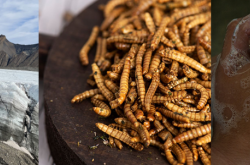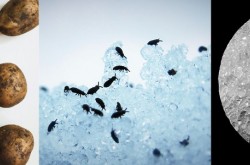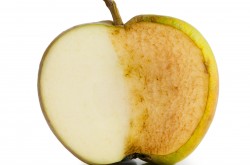3 things you should know about whether we need scarecrows to scare crows, how to preserve your garden harvest using science, and whether supersonic air travel will return with a Concorde 2.0

Meet Renée-Claude Goulet, Erin Gregory, and Danielle Vinson.
Renée-Claude is Science Advisor at the Canada Agriculture and Food Museum, Erin is Ingenium’s Curator of Aviation and Space, and Danielle is a cognitive science student at Carleton University in Ottawa who has a passion for science and storytelling.
In this colourful monthly blog series, experts at Ingenium and occasional guest writers offer up interesting and sometimes quirky nuggets related to their areas of expertise. For this October edition, Erin fills in for the Canada Aviation and Space Museum’s usual contributor, Science Advisor Cassandra Marion. Danielle was invited by Renée-Claude to contribute as this month’s three-article blog. This month’s three experts discuss whether we need scarecrows to scare crows, how to preserve your garden harvest using science, and whether supersonic transport airliners will return with a Concorde 2.0.

Flying carrion crow (Corvus corone) with a bun in its beak.
Do we need scarecrows to scare crows?
It’s that time of year again, Halloween is fast approaching. During the fall, you’ll probably encounter lots of fun Halloween characters, including scarecrows. Aside from adding to your Halloween décor, scarecrows have been used by farmers for a long time. But where do scarecrows come from, and are crows really that bad for farms? Read along to find out.
Did you know that scarecrows have existed for thousands of years? In ancient Egypt, farmers created simple scarecrows by draping nets over wooden frames to catch birds. The farmers would hide, then scare the birds so they fly into the nets. In ancient Greece, Rome, and Japan, scarecrows took on a more human-like appearance, more similar to scarecrows today. Scarecrows were created to keep birds and crows away from fields. But are crows bad for farmers?
The answer is a bit complicated, and not everyone agrees whether the good crows do outweighs the bad. Yes, crows can harm farms. They are omnivores, and eat pretty much anything, including crops. Nowadays, it’s much less common for farmers to have these problems, though crows can still cause significant damage to individual farms. However, crows can also be blamed for things that they don’t do. For example, crows can damage corn plants, but other birds and rodents do this, too. Crows can also eat peanut plants, but it’s grackles that are responsible for most of this damage.
When crows cause enough damage to need an intervention, scarecrows usually don’t cut it. Using poison or shooting is never the answer, because these methods don’t actually change crow numbers long term. Farmers can try covering their crops, using scare tactics, or creating another food source that crows can eat instead.
On the flip side, crows can help farmers and the community. They can eat harmful insects, which can be beneficial to agriculture. They also help with seed dispersal in two ways. Crows create stockpiles of seeds in different areas, and some of these seeds will grow into new plants. Crows also eat seeds, from fruits or grasses for example, and poop them out in a different location, thereby helping the seeds to spread. Some people even say crows could be the most important land birds for seed dispersal! Finally, because crows also eat carrion, they help clean up dead animals.
Another interesting fact about crows is that they are very smart. In fact, they have shown the same reasoning skills as five to seven-year-old humans! Crows also use tools. They have been observed taking nuts into the middle of the intersection at a red light. When the light turns green, the cars crack them. When the light turns red again, the crows pick up their freshly cracked nuts. Crows also have an amazing memory. In fact, they remember faces. If people are mean to them, they’ll keep track, and even tell other crows in their communities about it. This knowledge gets passed down through generations.
In sum, yes, crows can damage crops and this sometimes needs an intervention. However, they also help the community and they’re incredibly smart animals. Although scarecrows might not keep the crows away, they can still work for other birds and, when we use them, we’re taking part in a very old tradition.
By: Danielle Vinson

Blanching is one of the easiest ways to make sure your frozen vegetables stay tasty.
Preserving your garden harvest, using science!
So you've worked all spring and summer, planting and tending to your garden, and what started as delight at harvesting your own food soon turned into, "what do I do with all these tomatoes?" Now is the time to preserve! But how can knowledge about the science behind food preservation help us keep our food delicious long-term?
Pickling isn’t the only way to enjoy the harvest year-round. There's freezing, drying, packing in oil, salting, sugaring, fermenting, and more. All these food preservation techniques come down to creating conditions that slow the natural processes of rot.
When preserving food, we’re working against biology; all living things eventually die and decompose. Even though it's no longer connected to the rest of the plant, the food we harvest is indeed alive. Chemical processes are still ongoing in the cells, which is part of what causes post-harvest ripening and decay. The main actors here are enzymes, which are little proteins that participate in many chemical reactions, helping transform products into others. Enzymes in our food can react with oxygen to turn things brown, they can convert starches into sugars, and they can break down tissues and certain nutrients. Over time, enzyme activity changes the nutritional value, taste, texture, and colour of food.
The second thing to consider is that food is covered in microbes, such as yeasts, moulds, and bacteria. This is inevitable since our environment is naturally full of these microbes, on surfaces, in the air, on our skin, in the soil...everywhere. Initial cell decay by enzymes allows these microbes to get past food's protective barriers (peel). When these organisms settle in, they further break down our food and create waste products that taste bad or, in some cases, are toxic to us.
So how do we beat rot? There are a few ways!
First, we want to prevent enzymes from working. Blocking air-contact will help prevent the activity of many oxygen-activated enzymes. Since they are sensitive to temperature, many enzymes can also easily be deactivated by high heat. In comes a term you have probably heard before; blanching. This technique involves briefly boiling or steaming the produce, and then dunking it in a bath of ice water. Once deactivated, enzymes won't change the food. This is especially important in order to preserve the quality of food you are freezing or drying.
Just like us, many microbes need water, oxygen, a neutral pH, and a food source to thrive. To stop these organisms, we must find ways to kill them or to block them from their resources. For example, heating will kill or deactivate certain microbes. Pickling creates an acidic environment which prevents organisms from reproducing, and sometimes even kills them. Very salty or sugary environments affect the way microbes can use water, thus stopping them in their tracks. Dehydrating removes water from the food, which, again, creates an environment where micro-organisms can't really do much, since they require a moist environment.
Another approach is to store food in a cool, dark, and slightly humid environment. This delays food's natural enzymatic decay, reduces evaporation that makes food go limp, and keeps micro-organism activity low. This works well for root vegetables and cabbage, and is the principle behind root cellars.
A little food preservation knowhow can go a long way in helping us prevent food waste. In fact, food scientists are constantly innovating and learning about more applications of these basic food science notions. Preservation technologies applicable on a large scale are important as we seek to rescue more food from our supply chains, which requires easily and quickly preserving food about to go bad. And as more people develop an interest in growing food at home or in community gardens and hobby farms, knowing a bit more about what's happening when we are preserving can help improve our rate of success! Now that you know a bit more, which preservation techniques will you be trying in order to make the most of the fall bounty?
By: Renée-Claude Goulet

A British Airways Concorde takes off in the early 1970s.
Concorde 2.0? The Return of Supersonic Transport Airliners
Imagine flying from London to New York in three hours or less! Supersonic commercial flight could make that possible. Supersonic is one of four speeds, or regimes, of flight: subsonic, transonic, supersonic, and hypersonic. Subsonic flight is what many of us are used to as the commercial jets we travel in travel at speeds less than the speed of sound. The transonic regime refers to flight at the speed of sound, which is about 1,236 km/h at sea level. Supersonic flight means that an aircraft is flying faster than the speed of sound. These speeds are referred as Mach numbers. Flight that is faster than the speed of sound, or Mach 1, is supersonic and that regime of flight includes speeds of up to five times the speed of sound, or Mach 5. The hypersonic regime includes speeds faster than Mach 5 up to Mach 10. Most of the craft that have ever achieved flight in this regime have been spacecraft.
Nearly 50 years ago, on January 21, 1976, the world’s first operational supersonic airliner made its first flight with passengers. Called Concorde because it was jointly developed by British Aerospace and the French firm, Aérospatiale, it was a marvel of aerospace engineering. With a cruising speed of 2,179 km/h, or Mach 2.04, Concorde travelled between London and New York in around 3½ hours, half the time of regular subsonic airliners. While Concorde was the height of aviation technology, it was far from glamourous. The interiors were designed to reassure passengers about flying in a supersonic airliner by looking very much like a standard airline’s business class. Speed was the luxury and nothing else. The price of a one-way ticket in the 1990s was $6,000, and therefore far from accessible to the average air traveler.
Financial problems plagued the program from the outset. The costs of development for Concorde were never recouped. Noise complaints about its sonic boom, the very loud, thunder-like noise heard when an aircraft breaks the sound barrier, meant a significant reduction in destinations and flight routes. It could not fly overland and was relegated to coast-to-coast flights only. Throughout the 1990s, the airplane began to lose its lustre, and the dream of supersonic passenger flight seemed to die with the final flight of Concorde on October 24, 2003.
In recent years, several organizations, including NASA, Virgin Galactic, and Boom Supersonic, are hoping to revive that dream and improve upon it – making supersonic air transport part of everyday air travel and as accessible as subsonic flight. These new airplanes will not be the new generation of Concordes however, and they will have to overcome the tremendous challenges Concorde faced throughout its 24 years of service. Supersonic transport (SST) engineers and the companies that employ them have many difficult problems to solve, even though they will not be starting from scratch as those who brought Concorde to life did. In air transport, weight is everything. So, building an aircraft that is as light as possible often means making it smaller. The smaller the airplane, the lower its capacity for passengers. In addition, everything inside must be scaled-down to conserve weight, meaning a lack of luxury finishings. Both these factors make it difficult to sell enough seats to make a profit.
There are also the problems of emissions and fuel consumption, which are considerably higher in supersonic airplanes, in addition to the loud sonic boom that would be just as unpalatable to the public as ever. SST engineers have their work cut out for them. Can they come up with the keys to a supersonic airliner that uses sustainable aviation fuels, is highly efficient with a high passenger capacity, and that is as relatively quiet as its subsonic counterparts?
Boom Supersonic is promising that its SST airplane, the Overture, will be faster, quieter, roomier, and more efficient than Concorde. The company is working toward the goal of offering affordable commercial SST flights in 2030. Time will tell if this supersonic dream will come true!
By: Erin Gregory
Enjoying the Ingenium Channel? Help us improve your experience with a short survey!







































